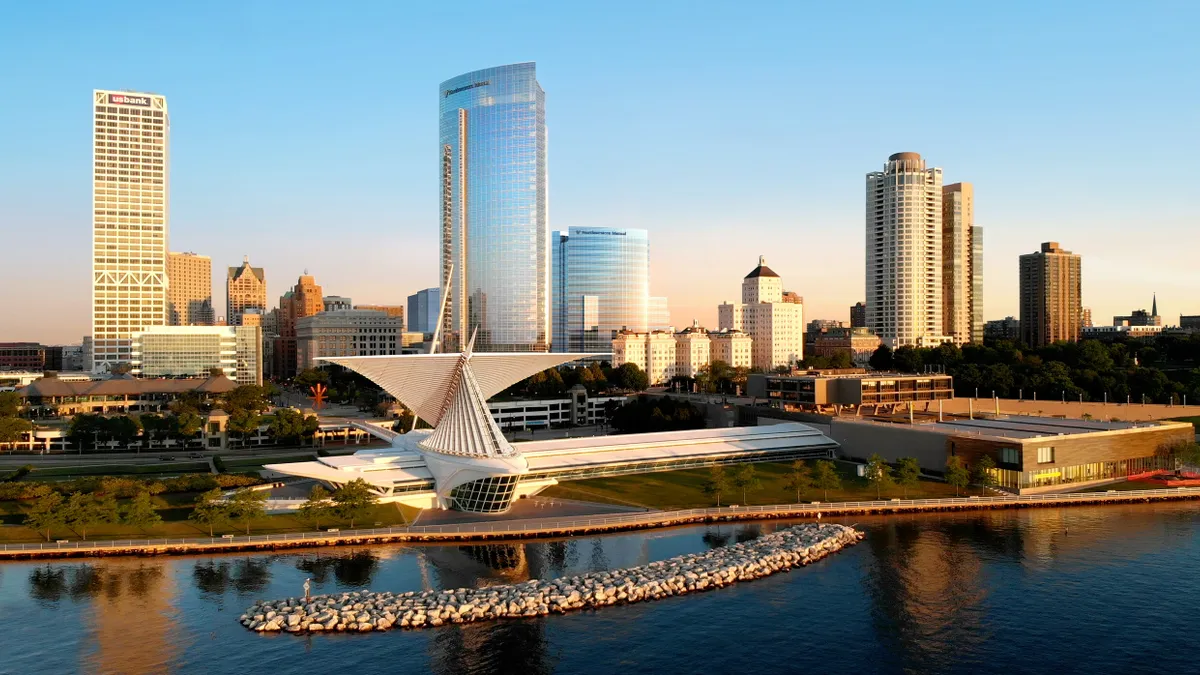It’s no secret that office construction lags pre-pandemic activity.
Starts in the sector will drop 6% in 2024, according to Dodge Construction Network. That’s hovering around the same level of activity in 2020 and about 22% percent off its peak in 2019. That weak demand also shows in building planning activity, which continues to fall in the office sector.
But despite the sluggishness in overall office construction activity, massive corporate campus and tower projects continued to break ground in 2023.
In fact, half of the top 10 commercial starts in 2023 were these types of trophy office sites, according to Dodge. Dodge classifies its commercial component as projects within the office, warehouse, retail, and hotel sectors. And there may be more to come, according to Richard Branch, chief economist at Dodge.
“I do expect those corporate campuses to pick up a little bit of strength again in 2024,” Branch said.
Top office construction starts in 2023
For example, Mutual of Omaha contracted Kansas City, Missouri-based construction firm JE Dunn to build approximately 800,000 square feet of office, meeting, collaboration and amenity space, as well as a parking garage for its new 44-story headquarters tower in downtown Omaha, Nebraska, earlier this year. The contractor expects to finish the $495 million project in 2026.
Meanwhile, Providence, Rhode Island-based Gilbane and Milwaukee-based CG Schmidt will perform $500 million in interior and exterior renovations to the 540,000-square-foot Northwestern Mutual office tower in Milwaukee. The project will enhance the insurance company’s employee amenities and event spaces, as well as increase the usable square footage of the campus. It will also connect to a pedestrian plaza.
Additionally, London-based Balfour Beatty broke ground earlier this year on the $518 million East Campus Building 4, an operational mission building project for the U.S. Army Corps of Engineers and National Security Agency in Fort Meade, Maryland. Plans for 2023’s most valuable office project include a 854,000-square-foot building with an open office layout, large flexible floor plates, food service areas and a modular parking structure, according to the contractor.
Loans coming due
Branch acknowledged there’s no solid dataset that explains the trend of these burgeoning corporate campus projects.
He said some may employ self-financing, which helps avoid the current headwinds of tight lending criteria and high interest rates that have plagued private development. Also, as more employers embrace hybrid work schedules, companies might ditch city offices for more regional sites, such as in secondary or tertiary markets.
Still, Branch admits these are just theories.
“Why? That’s a good question,” said Branch. “I don’t think the data is there yet to tell us exactly why.”
If self-financing is the driving force behind these shiny new corporate digs, though, the trend belies another aspect of office construction that is poised to unwind in the next couple of years: the increasing number and amount of loans that will soon come due.
The total amount of office debt in the U.S. reached $920 billion as of October 2023, according to a CommercialEdge review of more than 80,000 properties. Nearly $150 billion of those mortgages on U.S. office buildings are maturing by the end of 2024, and just over $300 billion of loans will mature by the end of 2026.
That level of debt maturity is a problem, said Anirban Basu, chief economist at Associated Builders and Contractors.
“I perceive great weakness out there that relates to the unrealized losses on bank balance sheets from the office market, the debt maturity wall facing the office market, and so on and so forth,” said Basu. “A lot of office building owners have to refinance their debt. That is going to really stop or diminish office construction going forward to what we have been accustomed to prior to the pandemic when the world was very different.”

















